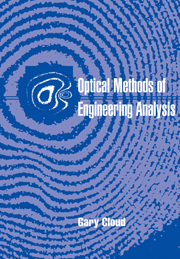Book contents
- Frontmatter
- Contents
- Acknowledgments
- 1 Introduction and orientation
- Part I Optics and interferometry
- Part II Photoelasticity
- Part III Geometrical moire
- Part IV Diffraction theory, optical processing, and moire
- 10 Diffraction and Fourier optics
- 11 Moire with diffraction and Fourier optical processing
- 12 Procedures of moire analysis with optical processing
- Part V Moire interferometry
- Part VI Holographic interferometry
- Part VII Speckle methods
- Author index
- Subject index
12 - Procedures of moire analysis with optical processing
Published online by Cambridge University Press: 12 January 2010
- Frontmatter
- Contents
- Acknowledgments
- 1 Introduction and orientation
- Part I Optics and interferometry
- Part II Photoelasticity
- Part III Geometrical moire
- Part IV Diffraction theory, optical processing, and moire
- 10 Diffraction and Fourier optics
- 11 Moire with diffraction and Fourier optical processing
- 12 Procedures of moire analysis with optical processing
- Part V Moire interferometry
- Part VI Holographic interferometry
- Part VII Speckle methods
- Author index
- Subject index
Summary
This chapter brings together many of the concepts discussed in the preceding five chapters to develop a moire technique that is superior to simple geometric moire but simpler than moire interferometry. The details of the procedures are presented in considerable detail. Many of the techniques described here, including specifics of using pitch mismatch, reproducing gratings, differential processing, and digital fringe reduction apply equally well to geometric moire and moire interferometry. In fact, many of the general ideas are useful in other areas of interferometry.
Introduction
A moire technique that incorporates spatial filtering has several attractive aspects. The fundamental idea is to take advantage of the sensitivity multiplication and noise reduction offered by optical Fourier processing of moire grating photographs, which are recorded for various states of a specimen. Sensitivity of the method can be controlled after the experimental data are recorded, within limits that are between those of geometric and interferometric moire. The method also is very flexible in that any two specimen states can be compared easily. The original data are permanently recorded for leisurely study later. Certain common errrors are automatically eliminated. Fringe visibility is usually much improved over that obtained by any method of direct or optical superimposition. Finally, the method is useful in difficult environments.
For orientation purposes, a short summary of a typical but quite specific procedure is presented first. Recognize that many variations in the procedure are possible, and the method is easily adaptable to whatever resources are at hand.
In the sections following the procedure summary, some specific details of technique are given. These details should be viewed as suggestive examples.
- Type
- Chapter
- Information
- Optical Methods of Engineering Analysis , pp. 241 - 266Publisher: Cambridge University PressPrint publication year: 1995

